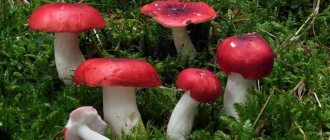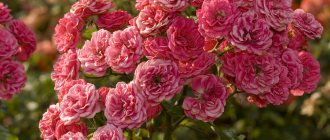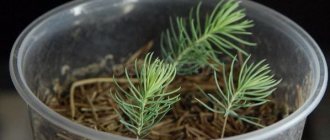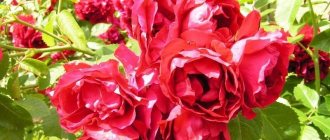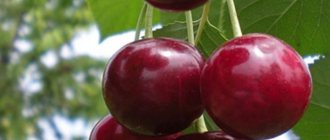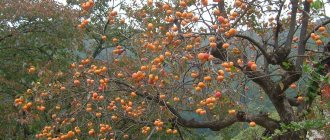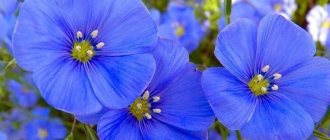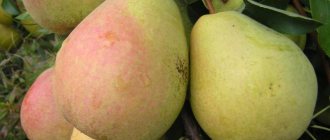The genus Dianthus has about 330 species, distributed in Europe, Asia, Africa, and North America. Let's take a closer look at the most popular representatives of this “divine flower”.
Among the variety of carnations there are perennials, as well as bi- and annual plants - herbaceous or in the form of subshrubs. In most types of carnations, simple green-bluish (from a waxy coating) lanceolate or linear-lanceolate leaves are located opposite on straight shoots.
Flowers are formed at the tops of the shoots, which can be either single or collected in loose inflorescences. Flower petals are red, burgundy, white, pink, sometimes lavender, greenish, yellow and orange. They often have small teeth on the edges or a thin fringe.
Sandy carnation, or Krylov's carnation (Dianthus arenarius, krylovianus)
In the wild, this perennial lives in the European part of Russia, Ciscaucasia, and Central Europe. Prefers forest and open sandy places.
The plant forms dense turf, with shoots from 10 to 40 cm long. In the second half of June, white or pale pink flowers with a diameter of up to 3.5 cm appear. The petals have hairs on the upper side, and an unusual fringe on the edges.
Popular varieties: Little Maiden (compact plant with white flowers), Nostalgie (up to 30 cm high, with white fringed petals).
Growing from seeds
Of course, annual varieties can be sown directly into the ground. But if you plan to achieve long-term flowering, then it is better to germinate them in a greenhouse and plant them in open ground when the weather warms up. Start the event in mid-February.
Prepare containers and fill them with suitable soil. You can use a universal mixture for seedlings or make your own substrate. To do this, mix the following components in equal parts:
- humus;
- peat;
- sand;
- garden soil.
Be sure to disinfect the mixture so that the seedlings do not die from harmful microorganisms living in the soil. To do this, heat the substrate in the oven, hold it over steam, or treat it with a solution of potassium permanganate.
Moisten the soil and evenly distribute the seeds over its surface at intervals of 1 cm. Lightly sprinkle them with sand, cover the container with glass or film and place in a warm, lighted place. The first shoots will appear on the 5-6th day. When the seedlings have two leaves, plant them in pots with a diameter of 6 cm. Caring for the seedlings involves regular watering and ventilation. When the fifth pair of leaves appears, pinch the crown. This will stimulate the growth of side shoots.
Dianthus superbus
This unpretentious and frost-resistant flower grows in meadows, forest edges, sea coasts, rocky slopes and sparse forests of temperate and moderately cold zones of Europe and Asia. It reaches a height of 50 cm.
Unlike the previous type, lush carnation forms a loose bush with fragrant flowers (4.5 cm in diameter), collected in a rare inflorescence. Their petals can be white, pink or purple. Flowering is observed at the end of June (lasts about a month) and in the first half of August (again).
The variety most often grown in cultivation is Breath of Love (with snow-white or pink flowers with jagged petals) and a mixture of white, pink and purple carnations under the general name “Lush” .
Dianthus deltoides
This perennial herbaceous plant is found on the territory from the Atlantic coast of Western Europe (Spain, France) to Siberia, and also grows in some areas of India.
The height of the thin stem is from 10 to 40 cm. This carnation is often used as a ground cover plant: in rock gardens, rockeries and borders. The plant forms loose turf, the flowers are only 1.5-2 cm in diameter. In nature, their color is pink and carmine, sometimes white, and in cultivation there are varieties with patterns on the petals.
In gardens, the variety mixture most often grown is Canta Libra (short carnations with pink, red and white flowers that bloom 3 months after sowing the seeds), Maiden Pinke (plants with red rings on white and pinkish-red flowers, bloom the next year after sowing). As well as the varieties Fragrant Carpet (with a large number of red flowers) and Arctic Fire (up to 20 cm high, with white flowers with a red ring, flowering lasts from late May to mid-July).
Flower care
Carnations, photos of which are presented in the article, are quite unpretentious plants. But they still require attention and proper care. The following agrotechnical measures will help with this:
- regular but moderate watering;
- periodic feeding;
- loosening the soil.
In addition, you should prepare flowers for winter. And also, if necessary, fight diseases and pests.
Dianthus Knappi
This perennial subshrub grows on the grassy slopes of Hungary, Romania, and northern Italy. This is the only carnation with light yellow flowers found in the wild with this color, although this species also has a white-flowered form.
The flowers are small (up to 2 cm in diameter), with serrated petals. Flowering is observed from the end of June to the second half of August.
Common varieties: Yellow Harmony (with dense inflorescences of grayish-yellow color), Canary (bushes up to 35 cm high with lemon flowers).
Dianthus caryophyllus var. schabaud
This is a bush variety of garden carnation with a well-developed tap-type root system, gnarled stems from 30 to 60 cm in height and narrow, bluish-green leaves, the length of which can reach 12 cm. Large and fragrant single flowers of the Shabot carnation are semi-double and double, in diameter reach 4-7 cm. The color of the petals can be white, yellow, pink, red, cream and other shades.
Carnation Shabot blooms from July until the onset of autumn cold weather. The plant is used mainly for landscaping flower beds and borders in city parks, ideal for cutting.
The most popular Shabot carnation hybrids: Jeanne Dionysus (with white flowers), La France (with soft pink flowers), Pink Queen (with deep pink flowers), Aurora (with salmon pink flowers), Marie Chabot (with grayish yellow flowers), Fire King (with bright red flowers with an orange tint).
Diseases and pests of cloves, methods of combating them and photos.
Unfortunately, like all plants, carnations are susceptible to diseases and pest attacks. The most common diseases of garden carnations:
Cutworm caterpillars attack carnation bushes during budding, feeding on leaves and flowers that have not yet bloomed. Massive populations devour the plant in just one night. Since the caterpillars go hunting at dusk, at this time they can be destroyed mechanically, but it is better to immediately treat the clove bush with preparations such as Actellik, Fitoverm or Bi-58.
Thrips are a pest that feeds on the juices of cloves; as a result, all parts of the flower become deformed, become covered with a white coating and lose their decorative properties. If the clove bush is very damaged, then you should get rid of it. Less infected specimens must be treated with insecticides, for example, Arrivo or Zolon. Spraying of carnations is carried out at intervals of 3-4 times every 5 days.
The root-knot nematode is a pest of carnations that attacks the root system of the plant and forms swellings called galls on the roots. As a result, the carnation develops poorly, then the leaves begin to turn yellow and the flowers fall off. Diseased bushes must be removed and burned. Since the pest can live in the soil for years, the soil is thoroughly spilled with boiling water, and then it is treated 3-4 times with Aktara or Rogora solutions.
Rhizoctoniosis is a disease that causes rotting of the carnation bush at the root collar. As a result, the plant does not receive nutrients and moisture, it turns yellow and dries out. In damp weather, rhizoctonia can be identified by finding a brownish felt coating at the bottom of the clove stem. It is unlikely that it will be possible to save an infected plant, but for prevention, the plants are watered and sprayed with Bordeaux mixture.
Clove blight is a disease in which the clove stems gradually wither and begin to quickly turn yellow. Individual leaves and shoots may turn reddish. When cut, streaks and brown rings are clearly visible on the stem. Diseased clove bushes should be removed, the soil should be treated with a solution of potassium permanganate, and healthy plants should be sprayed with “Topsin” for preventive purposes.
Fusarium wilt . Signs of carnation disease are yellowing, and subsequently browning and wilting of the leaves of the plant. Pinkish convex spots appear on the above-ground parts of the carnation bush - these are fungal spores. The affected cloves must be removed, and the remaining plants must be watered with a fungicide such as Fundazol or Topsin-M.
With the onset of cold weather, mice are very fond of feasting on the roots of garden carnations, so if you grow the plant as a perennial, cover it with spruce branches in the winter to avoid damage to the bushes by rodents.
Clove Grenadine (Dianthus caryophyllus var. grenadin)
Another popular variety of garden carnation. This perennial is most often grown as a biennial: in the first year the plant forms a rosette of leaves, and in the second year it blooms profusely.
The flowers are either simple or double (up to 6 cm in diameter), and the bushes themselves are compact or spreading. Narrow feathery leaves are dark green with a bluish bloom, collected at the base of the bush. Fragrant flowers are located at the ends of the stems, usually in small groups. Their color can be yellowish, red, burgundy, pink, lilac or white; there are also varieties with variegated colors in the form of dots, streaks and with a border at the edges of the petals.
Popular varieties: Feuerkönig (with red flowers), Rosakenigin (with bright dark pink flowers), Gloria (with red flowers), Lady in Black (deep burgundy flowers), Carrot King (with bright red flowers).
Rules for planting a cute flower
Having examined the most popular varieties of carnations, you will notice that this flower is widely used to decorate summer cottages. But, despite the sophistication of the cultivated species of this plant, wild varieties are valued no less. Among them are carnation grass and garden carnation. By growing these varieties in the front garden at the dacha, you can add notes of pristine nature to your mini landscape.
Planting and caring for perennial grass carnation, a photo of which helps to see it in all its glory, includes the following work:
- sowing seeds;
- cutting method;
- timely watering:
- fertilizing the soil.
Before sowing wild carnation seeds, it is important to prepare the soil. To do this, it is disinfected with special means to kill possible pests in it. Then sand is added to the soil, mixed and small containers are filled. After this, you can sow cloves. It is better to keep the pots in a warm room at a temperature of at least 16 degrees. When the sprouts rise and get stronger, they are planted in a permanent place in the country landscape.
Soil preparation and seed sowing begin in early May. Thanks to this, the seedlings will be ready for the summer, when the threat of frost is minimized.
Planting carnation grass using the cutting method involves the following techniques:
- cuttings;
- propagation by layering;
- dividing bushes.
Cuttings begin to be carried out at the beginning of summer, selecting suitable plants. They should be up to 10 cm long. A cut is made at an angle, the lower leaf plates are removed and the cutting is placed in a container with soil. After abundant watering, the container is covered with film or agrofibre. When the seedling gets stronger, it is planted on the site.
The method of planting carnation grass using layering is not often used, because this requires very long plant stems. If there are any, an incision is made into the internode and buried with soil. As a result of abundant watering, the cuttings will grow roots. Now it can be dug up and planted in a new area.
Dividing a grass carnation bush is perhaps the most optimal option for planting a plant. This method is quite simple: a part of the bush is split off and planted in a new territory. Abundant watering and carnations are already growing in the front garden.
In order for the plant to bloom in the first year of transplantation, the process of dividing the bushes is best done in the second ten days of March.
Since carnation grass is an unpretentious plant, it is enough to provide it with timely watering and regular fertilizing of the soil. The main condition is to control the humidity so that the roots of the cloves do not rot.
Planting and caring for perennial garden carnations is carried out in a similar way. In order for the plant to bloom as long as possible in a summer cottage, it is better to plant it in sunny places. Timely feeding and regular watering will ensure comfortable prosperity for the plant throughout the season. In addition, it is advisable to remove faded buds from the shoots to allow the plant to take root. In winter, garden carnations are covered, especially if there is little snow in the region.
Then the red carnation, a symbol of kindness and true love, will always flourish in the landscape design of the dacha.
Chinese carnation (Dianthus chinensis)
This is a perennial or annual shrub with knotty stems (15-40 cm high) and narrow, long, sometimes curled leaves. The flowers, colored pink, burgundy, purple, lilac or white, come in single or double forms, often with indented petals with a characteristic border around the edges. Flowering occurs from early June to early August.
Thanks to its compact shape, Chinese carnations can be grown not only in the garden, but also in a container on the balcony.
The flowers of this carnation are practically odorless. They can be single or collected in inflorescences of 2-4 pieces.
The Diana Mix F1 series of hybrids has become especially popular (there are white, scarlet, cherry, dark red and red flowers with a white border or a light center). Also in flower beds you can find the dwarf variety Telstar Purple Picoti (the pink-red center of the flower is surrounded by petals, the color of which gradually turns from pink to white).
Other types of cloves are also found in cultivation: Freyna, short-stemmed, rocky, etc. But they require more painstaking care and good drainage, since they risk dying from excess moisture and damping off in winter and during thaws. Therefore, they are cultivated less frequently in the middle zone.


